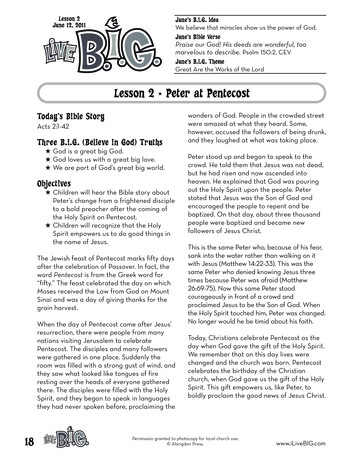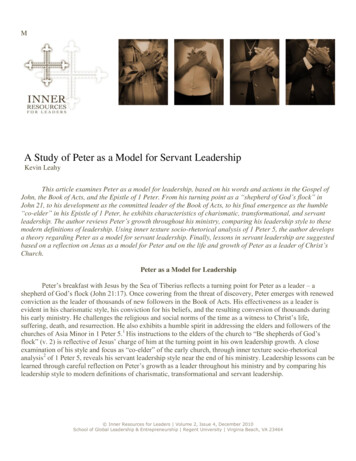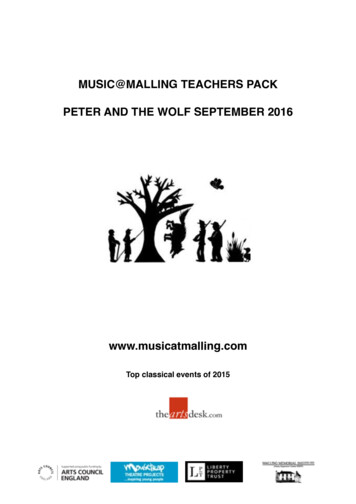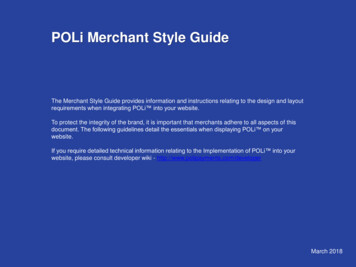
Transcription
UnSelling - Sell Less to Win Moreby Peter BourkeCopyright 2011 by Better Way Strategies, LLC, Alpharetta, GeorgiaFor more information, visit http://www.betterwaystrategies.com.Company and product names mentioned herein are trademarks or registeredtrademarks of their respective owners.All rights reserved.
UnSelling - Sell Less to Win Moreby Peter BourkeTable of ContentsTable of Contents3Introduction: UnSelling To Win More Business5Chapter 1: “Selling” Doesn‟t Work8Chapter 2: The Alternative: UnSelling (Think 7up - The Uncola)14Chapter 3: UnSelling Practical Examples and Applications191. UnSelling: It‟s All In the Words You Use!202. Using Provocative Point-Of-View (PPOV) Statements223. Qualify Early (And Often) With Small, Polite Confrontations234. “Whiplash” Questions265. More on “Let‟s Decide If It Makes Sense to Do This At All”286. Don‟t Conform; Consult With the Client about Their Evaluation Process297. The UnSelling Approach to the Discovery Process308. Really Understand Your Client‟s Business and Challenges339. Executive Access Is Not Optional3310. Executives, Especially, Don‟t Want to Be Sold3511. Above All Else, the Client Deserves the Truth3512. Provide the Client Alternatives to Build Trust3613. Don‟t Be a Jack of All Trades and a Master of None37
UnSelling - Sell Less to Win Moreby Peter Bourke14. Resist “Death by Powerpoint” at All Costs3815. Accelerating Discussions that Are Perfectly Illogical (To “Selling” People at Least) 3916. Give Your Competitors Some Credit (Sort Of)4017. If The Prospect is Doing Something Difficult, They Deserve to Know4318. Using the “Walk Away” Strategy to Win?4519. While You UnSell, Let Your Client References “Sell” to Their Heart‟s Content4620. UnSelling Doesn‟t Stop at Contract Signing4721. UnSelling Begins With Account Management4822. Without a Roadmap, Any Old Selling Road Will Get You Nowhere49Chapter 4: You Know You Have It Right When 50About The Author53
UnSelling - Sell Less to Win Moreby Peter BourkeIntroduction: UnSelling To Win More BusinessThe more you sell, the less the client trusts you to tell them thetruth. The more you sell, the less inclined the client is to listen.The more you sell, the more you tend to look (and act) like ahammer looking for a nail – where any nail will do. In reality, themore you sell, the less you win.This position is entirely counter-intuitive to the averagesales person, mostly because we are taught from the first day ofsales training that the key to success is great sales techniques. Youcan find thousands of books on the art and science of selling – techniques,tricks, even scripts to “sell” the prospect. Our corporate sales training classesalways insist that sales is about understanding the prospect‟s needs and thenarticulating your solution so that the prospect is compelled to choose your obviouslysuperior solution – right? Not so fast!The Background on UnSellingI was trained, starting in 1980, by one of the premier sales organizations in theworld – the IBM Corporation. I went on to work at some great and highly successfulcorporations/organizations including Nynex (now Verizon) and Andersen Consulting(now Accenture) where I headed up worldwide business development for this marketleading consulting organization for much of the last half of the 90‟s. Interestingly, eventhese well-respected organizations instinctively tend to default to a “selling” model –focused on compelling the client to choose our product, solution, or approach becauseit is superior.Then in 1997 while at Accenture I conducted a market-wide evaluation of potentialsales methodology companies and evaluated an array of sales methodology firmsyou‟ve heard of (and likely been trained by) – including Miller Heiman, Target AccountSelling, and Solution Selling, among others. I ended up hiring a sales methodology andtraining organization I had never heard of – The Complex Sale (TCS). TCS was foundedby Rick Page (author of the best-selling book, Hope is Not a Strategy) and I choseRick‟s firm because he understood what few people I had previously met reallyunderstood – that sales success, particularly when selling consulting and professionalservices offerings, has little to do with having the best features and functions of yoursolution. In fact, the best solution loses more than half the time in competitive deals –over half!
UnSelling - Sell Less to Win Moreby Peter BourkeBased on our success at Accenture and my personal alignment with Rick‟sfundamental methodology and thought process, I decided to leave Accenture in 1998to share both Rick‟s methodology and my philosophy about UnSelling to many newand different clients in services-based businesses. I have managed and coachedthousands of sales people and led countless large pursuits. And while this littleunderstood concept of UnSelling has proven successful in many different organizationswith whom I‟ve worked, I‟d be remiss in not acknowledging the insight and knowledgethat Rick and his team of Principals have helped me understand and embrace andhave been instrumental in the market-tested development of these concepts whichhave been integrated in this book. I can confidently say that TCS has developed themost effective sales methods and tools to help sales people and teams to win dealsthey can‟t afford to lose.Before we cover the UnSelling philosophy and approach in-depth, I should provideone additional dimension central to developing this concept. Since the mid-90‟s, whileat Accenture, we made a decision to institutionalize the process of conducting win-lossreviews when we had either won or lost a large, strategic opportunity. And in nearlyevery organization I have worked with since that time I have either instituted (usingthird party client research firms) or personally conducted face-to-face executiveinterviews with client executives who were deeply involved in the decision process tofind out the whole truth, and nothing but the truth related to their decision.The reason a third party review is so powerful is that, in most cases, the clientwon‟t tell the sales team the truth. When asked, “Why did we lose?” you can likelyguess the most common client answer, “It was really a price decision.” Why is it thatthe client usually says “price” when asked by the direct sales team? Because it‟s theeasiest answer to give and usually is difficult for the sales person/team to refute. Infact, it‟s really pretty easy for the salesperson to then go back to management andexplain that it wasn‟t their fault – because it really came down to price. My experiencein these post-mortem reviews is that the client‟s rationale is rarely based primarily onprice. In most cases the losing team was outsold and the client doesn‟t want to havethe confrontation to say otherwise.All of these experiences – in coaching large opportunities, in conducting these winloss reviews, and in teaching sales strategy to thousands of sales people with TCS have been combined to develop this UnSelling philosophy. This may be the single,most powerful set of strategies to “sell” more effectively for the average sales person orteam.
UnSelling - Sell Less to Win Moreby Peter BourkeYou‟ll notice I commonly (and interchangeably) use the terms “client” and“prospect” throughout this book. Perhaps it‟s my consulting upbringing but I havealways felt that in order to embrace the appropriate relationship between buyer andseller, it‟s not only acceptable but even advisable to refer to the prospect as a client. Irecognize that they may have never bought anything from us to this point but whenyou adopt the UnSelling approach, the premise is that we can and should add valuefrom the first meeting with the prospect and they can accurately be considered aclient.Finally, any sales person (or organization) that embraces UnSelling will want toensure that all sales-related resources are aligned in dealing with your clients. If oneperson is very consultative and collaborative and the sales engineer or sales supportresource (or God forbid, the sales manager) is in full-throttle-selling mode, the client‟sperception will be reduced to the least common denominator – which is that we are aclassic “selling/telling” organization and should be treated as such. Don‟t bevictimized - get all of your selling-related resources on the same page with thisphilosophy!Let‟s dive in and perhaps the best place to start is exploring why “selling” doesn‟twork
UnSelling - Sell Less to Win Moreby Peter BourkeChapter 1: “Selling” Doesn’t WorkTo grasp the power of UnSelling (and the weakness of traditional selling) we needto understand the psychology of the buying and selling process and the motivations ofboth buyer and seller. Let‟s explore some tangible examples: When a sales person “sells,” the prospective buyer has an immediatenegative reaction. For example: you walk into a clothing store and a salesassociate walks (er, runs!) over to you and asks, “May I help you?” What‟syour answer nearly every time? “No thanks, just looking.” Think aboutwhat just happened. Even if you actually do need help your first reaction is“no” because you don‟t want to be sold. The crazy thing is that 30 secondslater (when you‟re convinced the salesman has retreated) you‟ll lookaround the store to actually get the help of one of these sales clerks.What‟s that all about? When we‟re being “sold” we are less likely to want tobuy. The same is true on a new car lot when you are ambushed by the carsalesman or just about any other environment where it‟s obvious that youare about to be sold to death in some cases! In fact, a friend of minerecently went to a major appliance retailer and was literally stalked by acommission-based sales associate as he was evaluating his options. Hiscomment to me, “I‟ll never step foot in that store again!” You and your sales team have just entered the client‟s conference roomwhere your request for a one-hour meeting with the key, executive decisionmaker has been granted. You proudly give the executive a copy of the halfinch thick (35 page!) presentation that you diligently prepared for a timesuch as this. Think carefully about the client executive‟s perspective at thispoint – he or she looks at the sheer size of the presentation materials theysee in front of them and they will conclude one or more of the following:“We‟ll never get through all of these slides in the hour I haveallocated – I am going to suffer a “death by PowerPoint!”‟“I certainly don‟t have time to ask any questions so I‟ll just nodagreeably and hope they finish on time.”“Better yet, I think I‟ll text message my assistant, Mary, and ask herto come into the meeting room in 15 minutes to announce that Ihave been asked to attend an unplanned executive meeting!”
UnSelling - Sell Less to Win Moreby Peter BourkeYou get the picture? Executives look at the sheer volume of information thatwe, as sales people tend to throw at them and get overwhelmed at the sight. Ican promise you that they don‟t say to themselves: “I can‟t wait to see the nextslide!” Or, as so often happens, we as sales people tend to “dash to the demo”early in the buying and selling process because we‟re convinced, “Once thisprospect sees what our product can really do, they will be compelled to buyfrom us!”In reality, the prospects in these and many other “selling” scenarios are neitherconvinced, nor are they compelled to buy from us when we use these types ofapproaches. Why, then, are so many sales people inclined to default to traditionalselling? There are a few logical reasons: We tend to know a lot about our products and love to share our knowledge(and passion) for what we do. We tend to believe that anything we can do to accelerate the decision/closeis better for us – which leads to skipping necessary steps in the processand defaulting to “teller” mode. And, we are often afraid to ask questions that may be perceived by theclient as being overly-invasive or that they might be uncomfortableanswering.In order to understand these and many other real-lifesituations where classic selling can be so counterproductive,let me provide two distinct perspectives that will give you someadditional context that became the inspiration for UnSelling.First, we‟ll review the key findings from win-loss reviews with clients. Then,we‟ll explore the dynamics of the buying and selling process and the criticalneed to change the typical “subservient” buyer-seller relationship to a collaborativerelationship.Win-Loss Reviews: The Whole Truth and Nothing But the Truth Having conducted, sponsored, and/or reviewed more face-to-face win-loss reviewswith customers than anyone I know, it‟s amazing how instructive the findings arewhen it comes to understanding what works (and doesn‟t) in the selling process. Hereare a few common themes that emerge that are surprisingly consistent:
UnSelling - Sell Less to Win Moreby Peter Bourke Your sales team and every other team you are competing with tend to saythe same things (granted, in different ways) to the prospect and theaverage prospect is unable to differentiate one solution from another. Theyhear our words, they see our conviction, and they see our solution detailsbut the ugly reality is that they can‟t really distinguish amongst optionsand often conclude:“The solutions I am evaluating are relatively alike and I can‟t reallydistinguish one from another.”“I have more than one reasonable option – which really means I‟mnot “stuck” with one choice.”And because of this, the 2nd, 3rd, and 4th best competitors in a salespursuit are actually motivated to make their solutions sound just-like thefavored solution – often because they have a cost/price advantage. If theycan make all the solutions sound alike they‟re able to leverage their priceadvantage. The “best” solution loses most of the time! I know you‟re first reaction:“That can‟t be! The client always chooses the best solution in their ownmind!” Think about it this way – if a Martian came down to earth andobjectively determined what percent of the time the customer actuallychooses the very best solution, what would you guess they‟d find? I haveasked this question of my workshop participants for many years and mostoften I hear answers between 20-50%. In reality, you can‟t rely on the bestsolution to win because it‟s usually not good enough to win by itself. RFP‟s (Request for Proposals – a formal, documented statement ofcustomer requirements) are not designed to choose the best solution. Huh?That doesn‟t make any sense you say? Stay with me on this! Most often,RFP‟s are designed to prove that whoever the buyer intended to choose in acompetitive evaluation is actually chosen. That‟s a sobering thought – andhas significant implications for how we can best work with these prospects. The dreaded “do nothing” decision is often the biggest competitor yoursales teams face. Experience shows that your prospect is most inclined tostay with what they have today, often because the pain of change is greaterthan the pain they experience today with their current solution provider. Clients are motivated to mislead the sales person/team – and it‟s notbecause they are evil people. Most often, they tend to tell us less-than-the-
UnSelling - Sell Less to Win Moreby Peter Bourkewhole-truth so that they can maintain control in the buyer-sellerrelationship. They convince themselves that if we and other vendors knewthe truth (that we don‟t have a prayer of winning their business, as anexample), we wouldn‟t accommodate their needs and spend the time theyneed us to spend to help them not choose us (sound pretty crazy, doesn‟tit?) The real reason clients don‟t choose us is almost never really related toprice. Yes, the client will often say it was a simple matter of price whenasked but that is mostly because it is the easiest answer to give and it‟s thehardest argument for the defeated salesperson to overcome. Interestingly,when a third party executive like me asks the client the real reasons theychose whoever they chose, they sing a very different tune and will mentionthe real, non-price-related issues where the losing team has been outsoldby the competition! Far too often, we also find that a core reason for a loss is that is wasn‟t theright client and/or the right opportunity for the sales team to pursue. Inother words, had the account and opportunity been properly qualified earlyin the process, they wouldn‟t have pursued the opportunity and spent thelast 6-9 months chasing a deal they didn‟t have a reasonable chance to winin the first place. The sales team complied with the client‟s buying process instead of addingvalue and influencing the process. Successful sales teams walk into arelationship with a prospect with a pre-disposition that the first priority isto bring our expertise and knowledge in helping clients make informed,well-thought-out decisions so that they can choose the very best solution.Alternatively, less-experienced sales teams are so “delighted to be invited”that their inclination is to comply with whatever buying process thecustomer has devised, regardless of how flawed or incomplete it may be.We do ourselves, and more importantly, we do the client a disservice whenwe do so. And finally, we often find that the competitors who lose don‟t have astrategy. In fact when you ask them, “What was your strategy?” You getthese inquisitive stares and they‟re really saying, “Peter, what do you meanby “strategy”? Do you mean, „Are we preparing a proposal?‟” The emphaticanswer I always give is, “No!” We‟ll talk more about the importance ofstrategy in the next chapter!
UnSelling - Sell Less to Win Moreby Peter BourkeCustomers Want To Control the Buying and Selling ProcessIn your opinion, who is more qualified and experienced to define a set of steps andcriteria to thoroughly evaluate the reasonable alternatives to determine the very bestsolution for the client‟s needs – us or the client? If you hesitated with the answer,allow me to explain why the answer is an obvious one: we are!Great sales and business development people are clearly the most qualified! Why?Because we do this for a living. We see clients do it well. We see them do it poorly.We‟ve seen the good, the bad, and in more cases than we care to admit, we‟ve seenugly client evaluation and decision processes that end up with them choosingsomething less than the ideal answer. It begs the question – when‟s the worst time forthe prospect to figure out that they had a faulty process that selected the wrongsolution? After they‟ve signed a contract with the fourth best solution! Shame on us ifwe let them make that mistake!So here‟s the paradox – the prospect has every intention of managing andcontrolling the buying and selling process because they want to be in control. Theywant to control the flow of information and they want you to hear only what they wantyou to hear. Specifically, that you are a reasonable option for them (which may ormay not be true).In fact, what they really want us to believe is that we are a viable solutionalternative and that we have a realistic opportunity to win their business. Once again,they don‟t do this because they‟re mean-spirited or evil-natured! They treat us thisway because they need us to be engaged in their process. Please don‟t confuse“needing” us to be involved with “wanting” us to be selected. They need us to providethem information, to show them our product demonstration, to deliver a competitiveproposal/price (so that they can negotiate effectively with their “chosen” vendor), andperhaps even to share some insights as to what other companies have done well. Itmakes perfect sense – except that this represents a sub-optimal relationship betweenbuyer and seller.What the buyer often wants, in order to achieve the above objectives, is a buyerseller relationship that is best described as “subservient.” One way to describe thisrelationship: the prospect says, “Jump” and the seller says, “How high?” In essence,they tell us what to do and when to do it, and we then do it without asking questions.When they want a demo, we ask delightedly, “When can we schedule it?” A subservientsales person doesn‟t ask challenging questions of the prospect; they don‟t challenge
UnSelling - Sell Less to Win Moreby Peter Bourketheir assumptions; and they really don‟t add much value to the client‟s evaluation anddecision process – and therein lies the problem with the subservient sales model.If you‟re used to working with clients and prospects that treat the relationship inthis way, we‟re doing them a disservice for a few key reasons: They don‟t get the best of our experience and insights. The experiencedsales person/team has worked with many organizations and seen clientsand prospects manage the buying process well (and poorly). This prospectdoesn‟t get the benefit of that experience. We have insights about the stepsthey should be taking, the people they should be involving, the criteriathey should be using, and the pitfalls they should be aware of – for theirbenefit (not yours)! When the prospect thinks of us predominantly as a “vendor,” their naturaltendency is to have their personal and professional defenses up in theirinteraction with us. Remember the example I shared previously about anyof us shopping at a clothing store? The parallel: you keep asking: “May Ihelp you?” and they keep responding, “No thanks, just looking.” For aslong as you act like a hammer looking for a nail – they‟re going to hesitateto deal with you openly because they‟re not convinced they‟re really a nail. And finally, if they do have a pre-disposition for one of your competitors,they will remain focused in their desire to mislead you about their intentand their preference – and will do all possible to convince you that youhave a reasonable chance of winning their business and their confidence.I know these facts can be somewhat demoralizing for the average sales person. It‟sthe precise reason I want to arm you with a different approach to selling that allowsyou to proactively change the nature of the relationship between buyer and seller –and seek to learn the truth and gain the client‟s confidence and preference in theprocess.Let‟s get to the details of the UnSelling approach in Chapter 2.
UnSelling - Sell Less to Win Moreby Peter BourkeChapter 2: The Alternative: UnSelling (Think 7up - The Uncola)7UP was launched as a lemon-lime soft drink in the 1920‟s by Howdy Corporationas a hangover cure (I‟m not making this up) and they developed an ad campaign in the60‟s that called 7UP the “Uncola” because it‟s not really a cola drink but it‟s arefreshing drink nonetheless. They had tag lines like, “put some UN in your life” and“Are you an Un?” It was a very effective marketing strategy that led customers toembrace 7UP as the alternative to traditional cola soft drinks.In the same way, UnSelling is a newand very different way to “sell.” Theessence of this approach to workingwith prospects and clients is ensuringthe prospect is convinced that we aren‟t a hammer looking for a nail. Said anotherway: UnSelling ensures that we can lower the buyer‟s natural defenses about someonetrying to “sell” them so that we can have a far more productive relationship with thebuyer that is built on trust and collaboration. A relationship where we can providehonest, useful advice and gain credibility (and preference) in the mind of the buyer.And by doing so, encourage them to share more information about their needs, theirpriorities related to this initiative, and their personal agendas – all of which improvesour ability to serve them effectively.What we‟ll explore in this book are the attitudes, tactics, and strategies that aren‟ttraditional selling approaches. In fact, from the client‟s perspective, it doesn‟t even feellike they‟re being sold. Let‟s look at the contrast between the two sales approaches:
UnSelling - Sell Less to Win Moreby Peter BourkeSubservient “Selling” ApproachCollaborative, UnSellingTM ApproachClient says, “Jump”; We say “Howhigh?”Client says, “Jump”; We say, “Sure,but why?”Client is always right and knows bestWe are the subject matter expert andthe client may not always be right (orbe most knowledgeable)Client is in control of the buying andselling processWe provide advice and counsel toguide the client in how to mosteffectively evaluate alternativesClient tells the seller what they thinkthey should knowClient tells the seller the whole truth and nothing but the truthClient is on the defensive when itcomes to the selling vendorClient is open and collaborative andimpressed by the degree to which theseller wants the client to make aninformed decisionThe client will be helped when we‟rechosen as the solutionWe‟re going to start helping andadding value from the first meetingwith the client in the process
UnSelling - Sell Less to Win Moreby Peter BourkeLet‟s bring one more dimension into this equation: the timing of the buyer-sellerstrategies covered above. It will be helpful to review another key concept that RickPage (the Founder of The Complex Sale and author of the best-selling book, Hope isNot a Strategy) initially introduced to me in 1996 when I was his client at Accenture.Rick is the foremost authority on the concept he calls the Death Valley SalesCanyon. I won‟t attempt to explain the intricacies of the concept (you‟ll have to readRick‟s book for that) but the basic premise is that if you picture the buying and sellingprocess as a canyon that you, as a jet fighter pilot, are about to try to navigate, you‟llfind it is far easier for the seller to navigate and gain control in the early part of thebuying-selling process for one major reason – the client needs us. One more time –please don‟t assume that needing us is equivalent to wanting us. Most of the timethey need us, but in many cases they don‟t actually want us to win their business. Doyou see the distinction? 2011, The Complex Sale, Inc. All Rights Reserved.The buyer needs us for many things – to provide product information; todemonstrate our capabilities; to contrast our solution with others they may beevaluating; to share what other clients have done – good and bad; and to provide themadvice and counsel on what they‟re planning to accomplish. Once we understand thisconcept, you‟re less likely to be misled into believing that because the client is askinggood questions and seems genuinely interested in our advice they must “want” us!
UnSelling - Sell Less to Win Moreby Peter BourkeLet‟s take this one step further – when the client “needs” us (even though they maynot really “want” us to win), we have a unique opportunity to gain control in thebuying-selling process because we have leverage in early stages of the process(because they “need” us – see graph above) – making sense yet?This is why so many of the concepts and strategies that I outline in the nextchapter about how to UnSell effectively have an important timing dimension.Specifically, they tend to be most effective early in the buying process when the clientneeds you and when you, therefore, have leverage in the relationship. Think about itthis way: as you get to the later stages of the buying process (after the client hasgathered all of the information they feel they need to make an informed decision), thebuyer doesn‟t feel they “need” you anymore. They‟ve gathered information, they‟ve seendemonstrations, and they have your proposal and pricing. They accomplished theirgoal and can now decide. Or perhaps better said, they can now confirm that whomeverthey intended to choose in the first place is indeed chosen (and in many cases we havehelped them confirm that decision).What do we mean by having “leverage” in this buyer-seller relationship and how dowe use it to UnSell effectively? Here are three specific, priority examples: Gathering information (many organizations call this phase of the salescycle, “Discovery”). It is perfectly reasonable for a sales team to request,gather, and then review information provided by the client about thenature of the problem they‟re trying to solve, the severity (viaquantification) of the problem, and what they‟re doing today (or have donepreviously) to solve the problem. Gaining access to key executives: let‟s be careful to point out that thisdoesn‟t mean we “ask” for access to executive decision makers. When you“ask” you are inviting an easy “no” response from the prospect. In reality, ifthe buyer wants us to provide a well-thought-out solutionrecommendation, it is imperative that we meet and collaborate with the keystakeholders and decision makers. We‟ll cover the techniques for gainingthis access in more detail in the next chapter. Influencing the buyer’s evaluation and decision process is a thirdexample of how to use our leverage in the early part of the buying-sellingprocess. Most commonly, great sales people (and teams) are moreknowledgeable about how to define, organize, and execute an effectiveevaluation and decision process than the client. And if done well, it can beone of the most effective ways to build our credibility (by adding value), to
UnSelling - Sell Less to Win Moreby Peter Bourkehighlight our solution‟s strengths, and to expose the competitorsweaknesses – the trifecta!Let‟s summarize our intent in all of this before we get into some details on how toUnSell effectively in the next chapter. Our goals are as follows: To use the buying-selling process as an opportunity to establish ourcredibility and expertise – which is almost never established by providingproduct demos and 2-inch-thick proposals. To attempt to understand the whole truth and nothing but the truthin the discovery process with the client – because without the truth weare ill-equipped to provide an optimum solution (and we waste a lot of ourtime and the client‟s time). To add value in the buying-selling process – including the evaluationand decision pro
you‟ve heard of (and likely been trained by) - including Miller Heiman, Target Account Selling, and Solution Selling, among others. I ended up hiring a sales methodology and training organization I had never heard of - The Complex Sale (TCS). TCS was founded by Rick Page (author of the best-selling book, Hope is Not a Strategy) and I chose










